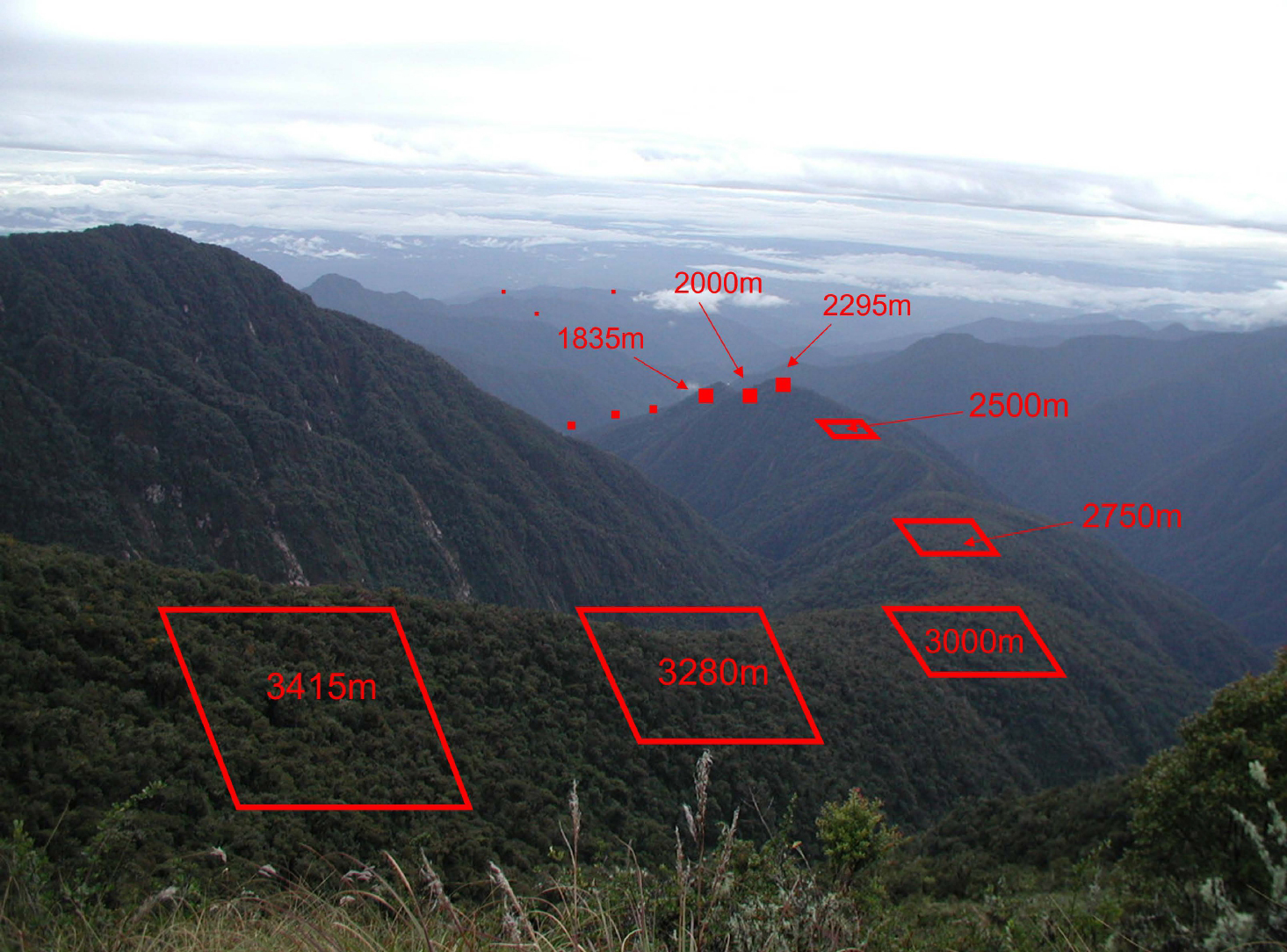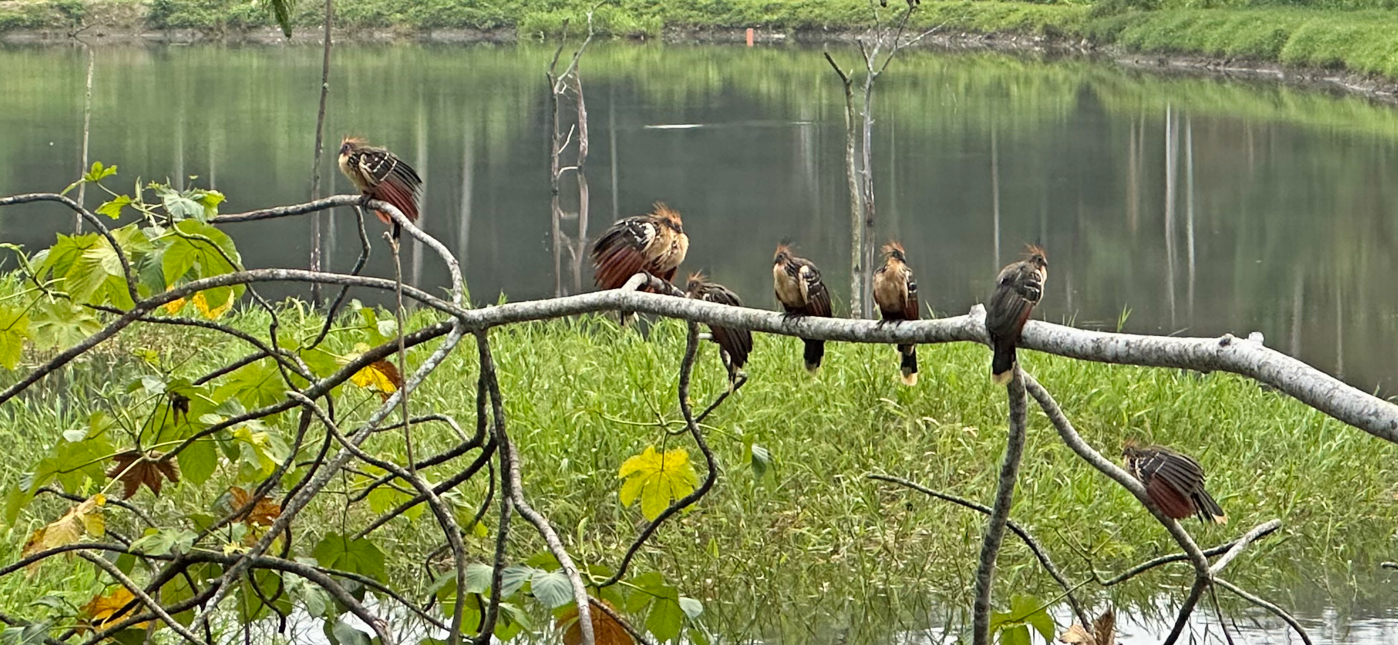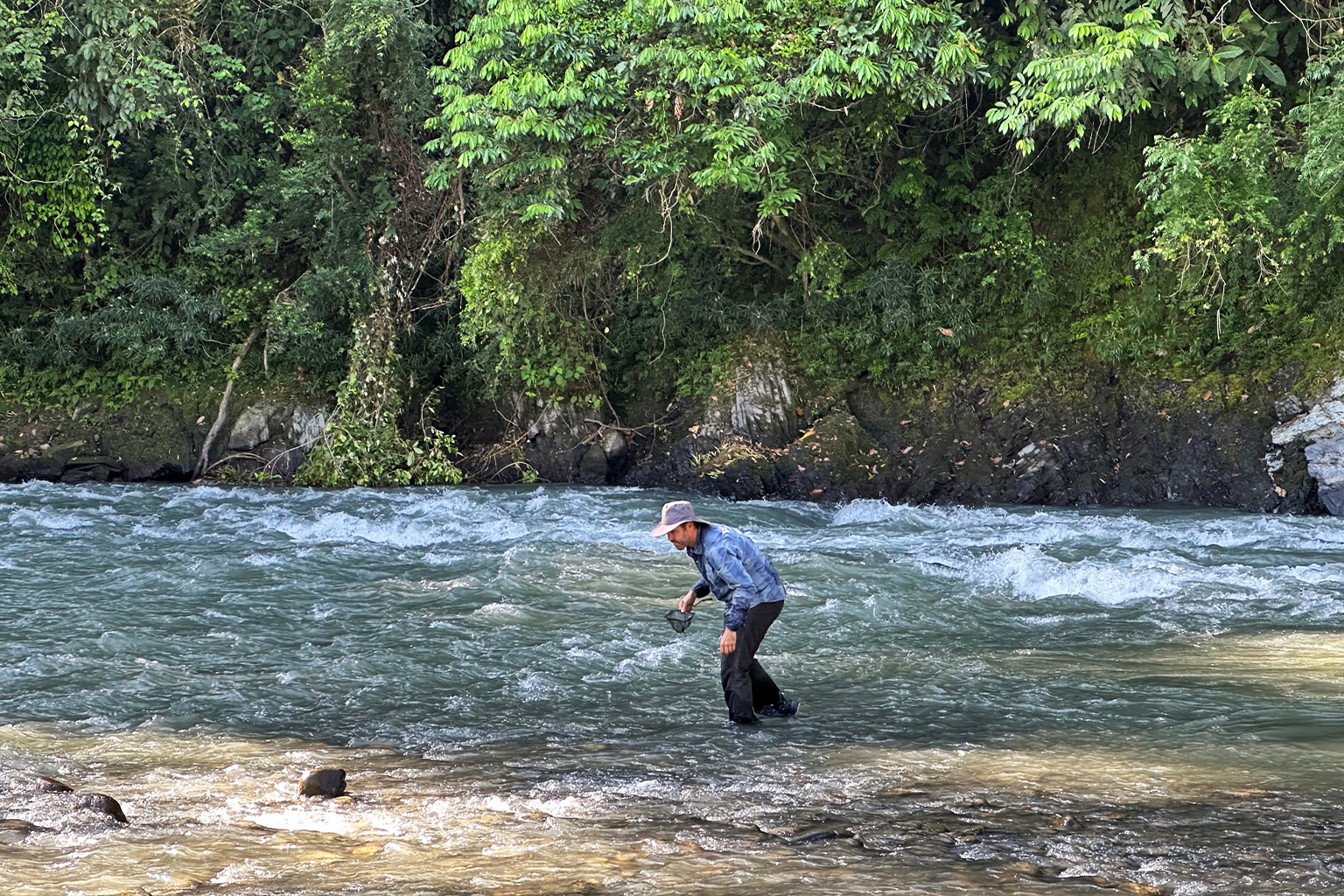- In its bold outlines, many informed people understand that climate change is reducing tropical biodiversity and thereby degrading the functionality and ecoservices of tropical forests. But what are the specific mechanisms by which these forests are being diminished over long time frames?
- One project on the slopes of the Peruvian Amazon has tried to make exactly that type of assessment, via a 20-year ongoing research project that meticulously observes a narrow transect of rainforest stretching from the Amazon lowlands near sea level to the Andean highlands above 3,352 meters (11,000 feet).
- The international team conducting this work, the Andes Biodiversity and Ecosystem Research Group (ABERG), is painstakingly observing changes in more than 1,000 tree species, birds, frogs, snakes and more to determine not only how much climate change is affecting them, but untangling how the change process works.
- This type of in-depth research is vital to conserving tropical rainforest diversity, the carbon storage capacity it offers, and its assistance in maintaining long-persisting regional and global precipitation patterns vital to agriculture and other water needs. Mongabay contributor Justin Catanoso traveled to Peru to observe ABERG at work.
PILLCOPATA, Peru — The trail through the lowland rainforest was dark and muddy. A half-dozen headlamps provided darting pools of light. An occasional creek bisected the path. Excellent conditions for frog spotting.
Alessandro Catenazzi, a conservation biologist at Florida International University and a leading herpetologist, was joined on this nighttime excursion by his graduate students and me. Seeing only leaf litter and underbrush where I shone my lamp, Catenazzi unfailingly spied tiny amphibians. Aside from a gorgeous poison dart frog, most were as yet unnamed species. But then …
“This is a map frog,” Catenazzi said, gently placing it in my open palm; it tucked calmly there, barely the width of two fingers. “Its mottled skin resembles a map,” he added. The frog tensed and leapt from my hand into the darkness, a fitting metaphor for the scientist’s findings.
Earlier in the day, Catenazzi had delivered a grim presentation on surging frog mortality to about 40 scientists at Manu Biological Stationwhere he’s been conducting research and observing changes to the southern Peruvian Amazon for decades. The group gathered in this remote jungle outpost had come from Europe, Canada, the U.S., U.K. and Latin America for the 20th anniversary meeting of the Andes Biodiversity and Ecosystem Research Group (ABERG).


ABERG, founded in 2003, has distinguished itself as a unique coalition of tropical scientists operating in, and focused on, a single common area, though with overlapping goals. That area covers a lone transect on the eastern slope of the Andes Mountains, stretching in an elevational gradient rising steeply upward from the Amazon lowlands near sea level, into the Andean highlands above 3,352 meters (11,000 feet).
The transect, described by some as the particle accelerator of tropical ecology, is an open-source rainforest field laboratory hosting a wide range of studies assessing the escalating threats from climate change over the last 20 years.
To advance that work, the transect is partitioned into 20-plus densely forested plots of 1 hectare each, harboring among the world’s highest diversity of trees, other plants, birds, mammals, amphibians and insects. The plots are staggered at elevations to reflect a roughly 1° Celsius (1.8° Fahrenheit) temperature change to help researchers observe the impacts of climate change on a wide range of species and soils as they are stressed by warming.
Two decades of intense focus on these plots has given ABERG scientists a growing, though still incomplete, understanding of how tropical species that thrive within very narrow thermal ranges are adapting, acclimating — or dying off — in response to warming.
It’s fair to say that these studies, providing two decades of data monitoring the health of this one elevational gradient in Peru, can serve as a key micro-level example of the health of global tropical forests and their ability to survive and continue mitigating the climate crisis.

“A collapse in real time”
Catenazzi, the frog expert, was not alone in presenting dire findings, but his results were perhaps the most dramatic.
“What we have with amphibians is an emergency that is one example of many that have affected species around the world,” he told me on the darkened trail. “With amphibians, though, it is something unprecedented in ecological and conservation history.”
In his research over recent years, Catenazzi observed frogs infected by a rapacious fungus, chytridiomycosis, that devours their skin and kills them. That fungus, showing no signs of abating, is most pervasive in higher elevations of the cloud forest in ABERG’s transect.
“Frogs in lower elevations like here [near sea level] are more plentiful; the fungus doesn’t seem to like warmer temperatures,” he explained. But “the cloud forest populations [above 1,500 meters, or 5,000 feet] are possibly extinct. We are witnessing a collapse in real time and it’s happening fast.”
Catenazzi described the die-off’s surmised connection with climate change. Warming, he said, didn’t bring the fungus to the tropics. But it appears to be driving the spread: “The highest elevation where this pathogen has ever been found is here in Peru,” and as Andean glaciers have receded in the past 30 years, frogs have moved farther upslope — to their detriment.
“The frogs occupied those new high-elevation ponds and brought the fungus with them.” There, the more virulent fungus spreads, killing more frogs.
This example shows how challenging it is to untangle the knotty relationships between escalating warmth, species migrations and extinction.
Every ecosystem is made up of a rich tapestry of interwoven species, dependent on one another for that ecosystem to thrive. But the loss of frogs flows like a disruptive ripple through the rainforest: Frogs aren’t pollinators like birds; they don’t enrich soils like ants and termites. Instead, they live in the middle of the food web, an important protein-rich food for a host of key predators such as birds and snakes … until the frogs vanish.


Fast change, slow trees
ABERG’s studies of tree migration have resulted in some of its most groundbreaking findings. As the rainforest warms,tree species are moving upslope, seeding and reproducing so as to keep living precisely within their long-evolved thermal sweet spots.
A trio of tropical ecologists — Miles Silman and William Farfan-Rios of North Carolina’s Wake Forest University and Ken Feeley of Florida’s University of Miami — have detailed in their research the spectacular tree diversity found in Amazonia from one elevation to another. And they’ve gleaned new insights into the challenges that tree species face when forced to move higher to beat the heat.
To understand migration mechanics, the researchers painstakingly identified 1,255 tree species along the transect starting in 2003, with each tree the width of a wine bottle or wider numbered and wrapped with an expansion band. Of those, 450 species remain unnamed by science, underscoring how much is still unknown about the vast biodiverse Amazon.
The staggering number of tree species wasn’t the only challenge complicating the researchers’ work; so, too, did species distribution by altitude. Along the elevational gradient, they found a mere 10% overlap in tree species between transect plot 1 at 3,415 meters (11,200 feet) and plot 4 at 2,750 meters (9,022 feet). But even more markedly, there wasn’t a single tree species in common between plot 1 at 3,415 meters and plot 8 at 1,835 meters (6,020 feet) — a distance one can hike in just a few hours.
Thus, the forest that may look uniform to the uninitiated eye is profoundly complex and, as a result, is severely stressed when its many species are forced to play a complicated game of heat-induced musical chairs.

ABERG research shows that all of the transect’s tree species are suffering climate-induced stress. And all are migrating upslope in response to warming — something trees did after the last Ice Age some 10,000 years ago. But natural climate change back then was far slower, and trees had thousands of years to acclimate, shifting range by hundreds of miles if necessary.
In Farfan-Rios’ presentation, he made clear that Amazonian trees haven’t been moving quickly enough in the past few decades since warming rapidly accelerated — likely dooming millions of them. Increased tree die-off in the decades ahead will inevitably reduce the ecosystem services trees provide to the Amazon biome and to the planet.
The Amazon Rainforest has commonly, and over-simplistically, been dubbed “the lungs of the Earth” for its capacity to “breathe in” and store heat-trapping carbon dioxide and “breathe out” oxygen and moisture to produce local, regional and global precipitation. With the loss of trees and that exchange, vital carbon storage is being lost, and life-giving annual Amazon rains are being replaced by drought.
ABERG tree migration studies have revealed another unsettling finding, according to research presented by ABERG co-founder Norma Salinas, a tropical ecologist with the Pontifica Universidad Catόlica del Peru in Lima. Over the years, the Andean tree line in the transect has remained inexplicably fixed, and hasn’t moved higher into the mountains, even as temperatures continue rising.
“We know that trees are moving,” Feeley tells me. “Over the last 20 years, we should see the tree line moving [higher], too. That’s not happening.” That means the available migration range is shrinking, with trees running up hard against a barrier beyond which they can’t go. “That’s making a big problem even bigger,” he adds.
Snakes chasing birds
Peru ranks second globally in bird biodiversity, only behind Colombia. Jill Jankowski, a zoologist and avian expert at the University of British Columbia, has spent years following this famously expansive bird population as it flits across ABERG’s transect. She didn’t hesitate when asked if rising temperatures are impacting avian species.
“Absolutely,” she told me during a break in presentations. “Climate change is creating a major challenge because of the uncertainty that all species face in new environments. It’s not just how their thermal environment is changing; it’s everything else — their [shifting food] base, the soils, their habitats, whether they will encounter unfamiliar predators.”
Jankowski said she lacked the data for definitive conclusions, but she has observed enough to say: “Things are going slower than they should for birds. And temperature isn’t the only factor.”
She offered the yellow-throated tanager, a major cloud forest species, as an example. It nests mostly above 1,200 meters (4,000 feet). Its range is not expanding, but its most dangerous predators are moving up from the lowlands to meet it.
“All of a sudden, all these nesting tanagers are going to be encountering more and more snakes,” she said. Not having lived among these reptiles previously, the birds “don’t have a natural history of defense. But they are keystone social members [that encourage] other species to flock in that forest type. If you take out the tanager, all these other social interactions will dissolve, making other species more vulnerable.”
To understand how these complex interactions degrade an ecosystem, it’s useful to do a kind of network analysis, she explained. Scientists can measure the links between species: How many different kinds of plant seeds, for example, does a fruit-eating bird disperse? These data help describe each thread in a living web. The number of threads and their network interactions determine the strength of that web. But climate change is degrading those threads.
“If you’re plucking away different connections, you’re weakening the web,” Jankowski said. “That’s what we’re faced with. How much of that web still needs to be intact before you start to see major failures in the ecosystem? There’s so much we still have to answer.”

“An important message”
If all this sounds bleak and remote from you and your life — as dozens of tropical ecologists gather in the Amazon near Peru’s Manu National Park to collectively decipher how one faraway ecosystem is failing in its race with climate change — you’d be right.
And wrong.
Across four days of PowerPoint presentations by international scientists — many of them Peruvians in their 20s along with their mentors in their 40s and 50s — the bleakness was implicit. But far more explicit was the palpable enthusiasm for their strenuous fieldwork; the excitement at sharing results, learning from colleagues, plotting their next experiments.
“This work, this job of mine, it’s terrifying but it’s also exciting,” Kim Lea Holzmann, 25, a Ph.D. biologist from the University of Würzberg in Germany, told me. She and her team are spending three months on the transect. “Like most people here, we want to make a contribution to this very big problem. I personally need some sense of importance in my life. I feel as if I am surrounded by so many passionate people who are trying to do the same.”
Julio Araújo Flores of Spain is a fish expert with an NGO in Puerto Maldonado, an area of gold mining-impacted Peruvian Amazon near the Brazilian border. He spoke at the meeting about the link between water quality and the health of tropical fisheries and freshwater habitats.


“Sometimes I think that I have a mission to explain all over the world what is going on here with the fishes,” Araújo told me. “We have to protect the things we’ve got. It’s a big message. An important message. The world needs to understand what we need to protect and why we need to protect it.”
Twenty years ago, Patrick Meir, an ecosystem scientist and soil expert at the University of Edinburgh, U.K., helped found ABERG. His were among the first experiments on the transect. Twenty years on, his students from Peru, the U.S. and Great Britain are professors with labs of their own and research projects on the transect.
“The combination of the size and majesty of the system here, coupled with the personalities that can deal with the unexpected elements of the rainforest and the physical challenges of working here, requires a special kind of person,” Meir told me as the meeting concluded. “This room is filled with them. And while most researchers are driven by a save-the-world desire, they are also fundamentally interested in the nuts and bolts of what’s going on. We surely need both.”
Banner image: The Peruvian Amazon has a greater diversity of birds than anywhere else on the planet, with 44% of all known species. This brilliant Andean motmot (Momotus aequatorialis) was spotted just off the transect located at around 1,524 meters (5,000 feet) of elevation. Image by Justin Catanoso.
Justin Catanoso is a regular contributor to Mongabay. He is also a colleague of tropical ecologist and ABERG co-founder Miles Silman at Wake Forest University in North Carolina.
FEEDBACK: Use this form to send a message to the author of this post. If you want to post a public comment, you can do that at the bottom of the page.
Tropical forest regeneration offsets 26% of carbon emissions from deforestation
